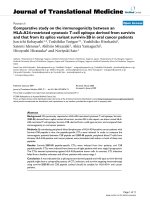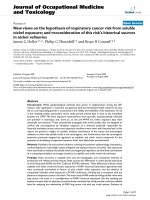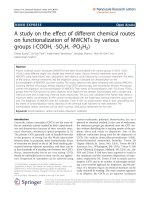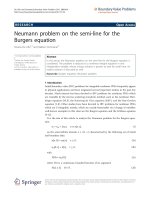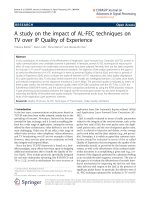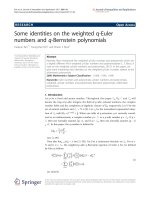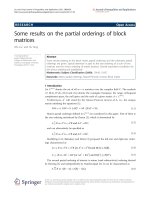báo cáo hóa học:" Long-term follow-up on the use of vascularized fibular graft for the treatment of congenital pseudarthrosis of the tibia" pdf
Bạn đang xem bản rút gọn của tài liệu. Xem và tải ngay bản đầy đủ của tài liệu tại đây (2.36 MB, 7 trang )
BioMed Central
Page 1 of 7
(page number not for citation purposes)
Journal of Orthopaedic Surgery and
Research
Open Access
Research article
Long-term follow-up on the use of vascularized fibular graft for the
treatment of congenital pseudarthrosis of the tibia
Akio Sakamoto*
1
, Tatsuya Yoshida
1
, Yoshio Uchida
1,2
, Tetsuo Kojima
1,3
,
Hideaki Kubota
4
and Yukihide Iwamoto
1
Address:
1
Department of Orthopaedic Surgery, Graduate School of Medical Sciences, Kyushu University, Fukuoka, Japan,
2
Uchida Orthopaedic
Surgery Hospital, Fukuoka, Japan,
3
Mizoguchi Orthopaedic Surgery Hospital, Fukuoka, Japan and
4
Saga Handicapped Children's Hospital, Saga,
Japan
Email: Akio Sakamoto* - ; Tatsuya Yoshida - ;
Yoshio Uchida - ; Tetsuo Kojima - ; Hideaki Kubota - ;
Yukihide Iwamoto -
* Corresponding author
Abstract
Background: Congenital pseudoarthrosis of the tibia (CPT) is one of the most difficult conditions
to treat.
Methods: Five girls and 3 boys with CPT were treated by vascularized fibular grafting (VFG). The
average age at VFG was 7.0 years (range: 1.9–11.5 years) with an average follow-up term of 11.7
years (range: 4.9–19.6 years). Five of the children had undergone multiple operations before VFG,
while the other 3 had no such history.
Results: Bone consolidation was obtained in all cases after an average term of 6.6 months (range:
4–10 months); this was with the first VFG in 7 cases but with the second VFG in 1 case.
Complication of stress fracture and ankle pain occurred in 1 and 3 cases, respectively, only in cases
undergoing multiple operations. Leg-length discrepancy was more prominent in the patients with
multiple previous operations (mean: 7.5 cm), than in the cases with no prior surgery (mean: 0.7 cm).
Conclusion: The long-term results of VFG for CPT were excellent, especially in the cases, with
no prior surgery. VFG should be considered as a primary treatment option for CPT.
Background
Congenital pseudoarthrosis of the tibia (CPT) is one of
the most difficult conditions to treat. The natural history
is persistent instability and progressive deformity [1,2].
CPT is known to accompany NF1 (neurofibromatosis type
1), also called von Recklinghausen disease. Treatment
options vary, including both surgical and non-surgical
approaches. Surgical techniques of vascularized fibular
grafting (VFG), intramedullary stabilization and external
fixation have been reported to be relatively successful in
the treatment of CPT [3-9].
We previously reported the cases of 5 patients with CPT
for whom good short-term results were obtained with the
use of VFG [3]. However, long-term follow-up studies of
VFG, particularly identifying limb-length discrepancy,
residual angular deformity and the rates of refracture are
necessary. All of those complications can compromise the
Published: 6 March 2008
Journal of Orthopaedic Surgery and Research 2008, 3:13 doi:10.1186/1749-799X-3-13
Received: 30 May 2007
Accepted: 6 March 2008
This article is available from: />© 2008 Sakamoto et al; licensee BioMed Central Ltd.
This is an Open Access article distributed under the terms of the Creative Commons Attribution License ( />),
which permits unrestricted use, distribution, and reproduction in any medium, provided the original work is properly cited.
Journal of Orthopaedic Surgery and Research 2008, 3:13 />Page 2 of 7
(page number not for citation purposes)
functional outcome, even though pseudarthrosis may
demonstrate bone consolidation [2,10]. In this study, the
long-term results of VFG were evaluated for 5 previously
reported cases and for an additional 3 cases. We specifi-
cally emphasize a comparison between patients undergo-
ing multiple operations and those with no prior surgery
before VFG. The previous surgerical procedures were in
the current series were all intramedullary stabilization
with/without bone grafting, which was not accompanied
by any method of microvascular bone transplantation.
Methods
This is a retrospective review of the clinical results in 8
patients with CPT managed with VFG performed by Y.U.
or T.K. at Kyushu University Hospital (Table 1). The
patients comprised 5 girls and 3 boys. Six of them had
NF1 (6/8; 75%). The tibia with pseudarthrosis involved
the right side in 5 cases and the left side in 3 cases. Ipsilat-
eral VFG was applied as a first choice, and contralateral
VFG was undertaken when ipsilateral fibula was not avail-
able. Consequently, ipsilateral VFG was applied in 7 cases
and contralateral VFG was applied in 2 cases, in which
one was for the initial trial of VFG, and the other was for
the second trial of VFG after failure of bone consolidation
in ipsilateral VFG.
Multiple previous operations had been performed before
VFG in 5 patients in other institutions prior to attending
our hospital. We have reported these patients in a study of
short-term follow-up [3]. For these patients, the number
of operations ranged from 3 to 8, the average number
being 3.4. The previous surgical treatments were all utiliz-
ing intramedullary nails with/without bone grafting. The
other 3 patients were added for the purpose of the current
study, and they had undergone no previous treatments.
We analyzed the term of bone consolidation, and compli-
cations comprising leg-length discrepancy, tibial deform-
ity of angulation, occurrence of fractures and existence of
ankle pain, in a comparison between patients with and
without previous surgical treatment before VFG. Bone
consolidation was analyzed by skilled orthopedic sur-
geons including some of the authors.
Operative technique
The method of VFG is summarized as follows: Before
operation, the vascular anatomy was determined by angi-
ography. Dissection of the vascularised (peroneal vessels)
fibula was performed. The fibula proximal to the pseu-
doarthrosis site was usually used for the donor. The thick
fibrous tissue around the tibial pseudarthrosis was
resected completely, whereas resection of the sclerotic
bone ends was minimal. After correction of angular
deformity, a slot was created to receive the fibular graft
which was secured by several screws. End-to-end anasto-
mosis was performed between the anterior tibial and the
peroneal vessels [3].
Statistical analysis
Clinical data were statistically analyzed using the Mann-
Whitney U-test for quantitative data of the term of bone
consolidation and leg-length discrepancy, and using
Fisher's exact test for qualitative data of the existence of
ankle pain. A p value of less than 0.05 was considered to
indicate statistical significance.
Results
Patients
The mean age of the patients at the time of VFG surgery
was 7.0 years old (ranging from 1.9 to 11.5 years old).
Average postoperative follow-up term was 11.7 years
(ranging from 4.9 to 19.6 years), and the average patient
age at final follow-up was 19.3 years old (ranging from 8.1
years to 27.3 years old). Recurrence was not seen in any of
the cases during the course of the follow-up.
Bone consolidation
Bone consolidation after VFG occurred in all the patients
(8/8: 100%). In the patients undergoing multiple opera-
tions, all 5 cases obtained bone consolidation after the
first VFG operation without any further surgery (Figs. 1,
2), while 1 out of the 3 cases without prior surgery failed
to obtain bone consolidation following the first ipsilateral
VFG at the age of 1.9 years old. A second contralateral VFG
was then undertaken for this patient at the age of 7.3 years
old, and bone consolidation was obtained 5 months after
the second operation (Case 6; Fig. 3). Counting the sec-
ond VFG in this case as data, the bone consolidation term
of all 8 cases averaged 6.6 months (ranging from 4 to 10
months), in which bone consolidation was obtained 7
months after the second operation in this case. In the
cases with no prior surgery, two out of the 3 patients
obtained bone consolidation within 10 months. The
bone consolidation term for the patients undergoing mul-
tiple operations was 6.8 months, while that for patients
with no prior surgery was 6.3 months. There was no sig-
nificant difference between these results (p = 0.77).
Complications
Leg-length discrepancy
The overall average postoperative discrepancy in all cases
was 4.9 cm (ranging from 0 to 15.7 cm). The leg-length
discrepancy for the cases undergoing multiple operations
was 7.5 cm (ranging from 0.6 to 15.7 cm), while that of
cases with no prior surgery was 0.7 cm (ranging from 0.0
to 2.0 cm) (p = 0.07). A discrepancy of more than 5.0 cm
was seen in 4 out of the 5 cases undergoing multiple oper-
ations, but in none of the 3 cases with no prior surgery.
For cases undergoing multiple operations, leg-length dis-
crepancy with an average of 6.8 cm (ranging from 0.0 to
Journal of Orthopaedic Surgery and Research 2008, 3:13 />Page 3 of 7
(page number not for citation purposes)
Table 1: Vascularized bone-transferred cases with/without previous multiple operations
Case/Side/
NF1
Sex/Age Number of
previous
operations
Donor site Term until
union
Age at follow-up
(term)
Leg-length
discrepancy
(before VFG)
Residual
angulations
anterior/valgus
Stress fracture
(after VFG)
Corrective
osteotomy
Ankle pain
(after VFG)
Cases with previous multiple operations
1/L/+ F/7.4 yo 8 I 9 m 27.0 yo (19.6 y) 5.2 cm (5.0) 28/10 deg + (4 m) - + (12 y)
2/L/+ F/8.8 yo 3 I 6 m 21.6 yo (12.8 y) 5.8 cm (6.0) 21/0 deg - - + (9 y)
3/L/+ F/8.8 yo 7 I 5 m 27.3 yo (19.0 y) 10.2 cm (9.0) 5/3 deg - - -
4/R/- M/8.9 yo 4 C 5 m 22.2 yo (13.3 y) 0.6 cm (0.0) 18/2** deg - + + (11 y)
5/R/+ F/11.5 yo 6 I 9 m 18.5 yo (7.0 y) 15.7 cm (14.2) 0/0 deg - - -
Cases without prior surgery
6/R/- M/1.9 yo 0 I Non union
/7.3 yo 1* C 5 m 14.8 yo (7.4 y) 0.0 cm 0/0** (22/20) deg - + -
7/R/+ M/3.2 yo 0 I 10 m 8.1 yo (4.9 y) 0.0 cm 20/20 deg - - -
8/R/+ F/6.2 yo 0 I 4 m 15.3 yo (9.1 y) 2.0 cm 0/0 deg - - -
*; First trial of vascularized bone-transferred operations, **; data after corrective osteotomy, NF1; neurofibromatosis type 1, VFG; vascularized fibular grafting, L; left, R; right, M; male, F;
female, yo; years old, y; years, m; months, I; ipsilateral, C; contralateral, ant; anterior, valg; valgus, deg; degrees.
Journal of Orthopaedic Surgery and Research 2008, 3:13 />Page 4 of 7
(page number not for citation purposes)
14.2 cm) already existed. Therefore there was no signifi-
cant difference between the previous state (6.8 cm) and
the post state (7.5 cm) of VFG in the group of cases under-
going multiple operations (p = 0.84). The discrepancy
seemed to be related to the earlier surgical procedures
prior to VFG.
Tibial deformity of angulationDeformity of angulation
varied, with the tibial valgus ranging from almost zero to
28.0 degrees and anterior bowing ranging from almost
zero to 20.0 degrees. Deformity of more than 20 degrees
occurred in 4 out of the 8 patients (4/8; 50%), of which 2
were cases undergoing multiple operations (2/5; 40%)
and 2 were cases with no prior surgery (2/3; 67%). Two
cases had undergone corrective osteotomy, of which one
had undergone multiple operations and the other had
undergone no prior surgery (Cases 4, 6).
Fractures
One patient had a stress fracture 4 months after VFG (Case
1). The fracture was treated with a brace and it healed.
Ankle pain
Ankle pain was seen in 3 out of the 8 cases, regardless of
its severity. These pains appeared 12 years (at 19 years
old), 9 years (at 17 years old) and 11 years (at 19 years
old) after the surgery. The average term was 10.6 years and
the average age was 18.3 years old. It seemed to be charac-
teristic that these pains appeared at late adolescence.
These cases of ankle pain seemed to be associated with the
degree of tibial angulation. Moreover, ankle pain was seen
in 3 out of the 5 cases undergoing multiple operations,
but in none of the 3 cases with no prior surgery (p = 0.08).
Other factors
Gender or the existence of NF1 did not seem to have any
relationship with bone consolidation or any other com-
plications.
Discussion
In a series of VFG for the treatment of CPT, bone consoli-
dation was reported to be obtained in 94% of cases [4]. In
the current study, all cases with VFG obtained bone con-
solidation, with an average bone consolidation term of
6.6 months without recurrence. In a previous report, gen-
der may have been a significant factor in the length of
term needed for bone consolidation, on the basis that 13
boys had an average bone consolidation term of 13
months, whereas 16 girls had an average bone consolida-
tion term of 9 months [2]. In the current case, such a ten-
dency was not observed. In our institute, because of good
results of bone consolidation after VFG, VFG has been
chosen as the primary treatment, with the Ilizarov bone
transport method being an alternative choice. In a previ-
ous report, the Ilizarov bone transport method was
reported as being useful in achieving primary healing in
CPT, but complications of refracture and postoperative
deformities may occur [11]. Further examination of long-
term follow-up after the Ilizarov bone transport method is
necessary.
Congenital pseudarthrosis of the tibia (Case 1; a case undergoing multiple operations)Figure 1
Congenital pseudarthrosis of the tibia (Case 1; a case undergoing multiple operations). Eight operations was undergone before
VFG at 2.5 years old (A), Ipsilateral VFG was performed at 7.4 years old (B). At 23.5 years old, 15 years after VFG (C).
Journal of Orthopaedic Surgery and Research 2008, 3:13 />Page 5 of 7
(page number not for citation purposes)
As for VFG, it has been reported that age is an important
factor in the result of VFG, with regard to bone consolida-
tion. In a previous report, seven patients operated on at 10
years of age or older had successful outcomes, compared
with 12 out of 22 who were 9 years of age or younger at
the time of surgery [12]. According to the EPOS (Euro-
pean Paediatric Orthopaedic Society) Multicenter Study
[6], there was a clear correlation between age at surgery
and final outcome, with better results being achieved with
increasing age. Therefore, it has been proposed that sur-
gery should not be performed on patients younger than
the age of 3 years and it is recommended that surgery be
postponed until the age of 5 years [6]. Another study
about bone consolidation in CPT also suggested that the
best age for rapid bone consolidation is 3.5 years to 7.5
years old [4]. In the current study, one case aged 1.9 years
old did not obtain bone consolidation with VFG. For that
case, a second contralateral VFG was successful at the age
of 7.3 years old. This fact may support the notion that an
age younger than 3 or 3.5 years old is a negative factor
with regard to bone consolidation in VFG.
Tibial deformities of limb-length discrepancy and angula-
tion are common after treatment for CPT [2,4]. Bone con-
solidation of pseudarthrosis is not sufficient for
assessment as the end result. Occasionally, chronic lower-
extremity dysfunction and clinical symptoms may result
in amputation [7]. In the current series, a limb-length dis-
crepancy of more than 5 cm was seen in 4 out of the 5
cases undergoing multiple operations but in none of the
3 cases with no prior surgery. The average leg-length dis-
crepancy for the cases undergoing multiple operations
was 7.5 cm, while that of cases with no prior surgery was
0.7 cm. The p value is 0.07, and the reason for there being
no significant difference statistically may be because of
the small number of these cases. Limb-length discrepancy
has been reported in half the patients with intramedullary
nails [7]. Such surgical procedures with a potential danger
of damaging the growth plate may result in limb-length
discrepancy. Therefore, the deformity may have been
related to an earlier surgical procedure prior to VFG [12].
Congenital pseudarthrosis of the tibia (Case 8; a case with no prior surgery) with no other operation before VFGFigure 2
Congenital pseudarthrosis of the tibia (Case 8; a case with no prior surgery) with no other operation before VFG. Preopera-
tion status at 6.6 years old (A). At 12.8 years old, 6.2 years after VFG (B).
Journal of Orthopaedic Surgery and Research 2008, 3:13 />Page 6 of 7
(page number not for citation purposes)
Congenital pseudarthrosis of the tibia (Case 6; a case with no prior surgery)Figure 3
Congenital pseudarthrosis of the tibia (Case 6; a case with no prior surgery). Preoperation status of VFG (A). Ipsilateral VFG
was performed at 1.9 years old (B). At 7.3 years old, bone consolidation can be seen 5 months after second VFG from the con-
tralateral side (C). At 14.8 years old, after corrective osteotomy of the lower tibia for the deformity (D).
Publish with BioMed Central and every
scientist can read your work free of charge
"BioMed Central will be the most significant development for
disseminating the results of biomedical research in our lifetime."
Sir Paul Nurse, Cancer Research UK
Your research papers will be:
available free of charge to the entire biomedical community
peer reviewed and published immediately upon acceptance
cited in PubMed and archived on PubMed Central
yours — you keep the copyright
Submit your manuscript here:
/>BioMedcentral
Journal of Orthopaedic Surgery and Research 2008, 3:13 />Page 7 of 7
(page number not for citation purposes)
Angular deformities do not remodel and are often pro-
gressive after VFG [5,13]. In the current study, a deformity
of more than 20 degrees was seen in 4 out of the 8 cases.
The relationship between the degree of angulation and
multiple operations before VFG is not clear. Ankle pain
was seen in 3 out of 8 cases. It seemed characteristic that
these pains appeared long after the VFG (mean, 10.6
years), and late in the second decade (mean, 18.3 years
old). These 3 cases had undergone multiple operations.
Therefore, it should perhaps be noted that there was a ten-
dency for previous unoperated cases to have ankle pain at
long-term follow-up, even though there had been no pain
of short-term follow-up. In a previous report, ankle pain
after the surgical procedure for VFG is associated with
multiple operations utilizing intramedullary nails, con-
sistent with our results [14], and degenerative changes in
the ankle because of the ankle valgus deformity and the
intramedullary rod passing through the ankle joint is con-
sidered to be the cause of the ankle pain [14-16]. Refrac-
ture is not uncommon following consolidation of VFG
[13,17,18]. In most cases, the first fracture is reported to
occur before the age of 1 year [4]. In the current case, one
out of the 8 cases had a stress fracture at the age of 7.4
years old, and casting healed the fracture.
Conclusion
In conclusion, the overall long-term follow-up results of
VFG were excellent. However, residual limb-length dis-
crepancy and ankle pain were prominent in cases under-
going multiple operations. In contrast, patients who
underwent VFG as a primary operation had fewer such
problems. Accordingly, VFG should be considered as a
primary treatment option for CPT.
Abbreviations
CPT; congenital pseudarthrosis of the tibia, NF1; neurofi-
bromatosis type 1, VFG; vascularized fibular graft, LLD;
leg-length discrepancy
Competing interests
The author(s) declare that they have no competing inter-
ests.
Authors' contributions
AS drafted the manuscript. YU and TK performed vascu-
larized fibular graft. AS, TY and HK participated in the
design of the study. YI conceived of the study, and partic-
ipated in its design and coordination and helped to draft
the manuscript. All authors read and approved the final
manuscript.
Acknowledgements
The patient's families were informed that data from the case would be sub-
mitted for publication, and gave their consent. The English used in this man-
uscript was revised by Miss K. Miller (Royal English Language Centre,
Fukuoka, Japan).
References
1. Boyd HB: Pathology and natural history of congenital pseu-
darthrosis of the tibia. Clin Orthop Relat Res 1982:5-13.
2. Morrissy RT, Riseborough EJ, Hall JE: Congenital pseudarthrosis
of the tibia. J Bone Joint Surg Br 1981, 63-B(3):367-375.
3. Uchida Y, Kojima T, Sugioka Y: Vascularised fibular graft for con-
genital pseudarthrosis of the tibia. Long-term results. J Bone
Joint Surg Br 1991, 73(5):846-850.
4. Gilbert A, Brockman R: Congenital pseudarthrosis of the tibia.
Long-term followup of 29 cases treated by microvascular
bone transfer. Clin Orthop Relat Res 1995:37-44.
5. Kanaya F, Tsai TM, Harkess J: Vascularized bone grafts for con-
genital pseudarthrosis of the tibia. Microsurgery 1996,
17(8)::459-69; discussion 470-1.
6. Grill F, Bollini G, Dungl P, Fixsen J, Hefti F, Ippolito E, Romanus B,
Tudisco C, Wientroub S: Treatment approaches for congenital
pseudarthrosis of tibia: results of the EPOS multicenter
study. European Paediatric Orthopaedic Society (EPOS). J
Pediatr Orthop B 2000, 9(2):75-89.
7. Dobbs MB, Rich MM, Gordon JE, Szymanski DA, Schoenecker PL:
Use of an intramedullary rod for treatment of congenital
pseudarthrosis of the tibia. A long-term follow-up study. J
Bone Joint Surg Am 2004, 86-A(6):1186-1197.
8. Paley D, Catagni M, Argnani F, Prevot J, Bell D, Armstrong P: Treat-
ment of congenital pseudoarthrosis of the tibia using the Ili-
zarov technique. Clin Orthop Relat Res 1992:81-93.
9. Guidera KJ, Raney EM, Ganey T, Albani W, Pugh L, Ogden JA: Ili-
zarov treatment of congenital pseudarthroses of the tibia. J
Pediatr Orthop 1997, 17(5):668-674.
10. Leung PC: Congenital pseudarthrosis of the tibia. Three cases
treated by free vascularized iliac crest graft. Clin Orthop Relat
Res 1983:45-50.
11. Kristiansen LP, Steen H, Terjesen T: Residual challenges after
healing of congenital pseudarthrosis in the tibia. Clin Orthop
Relat Res 2003:228-237.
12. Romanus B, Bollini G, Dungl P, Fixsen J, Grill F, Hefti F, Ippolito E,
Tudisco C, Wientroub S: Free vascular fibular transfer in con-
genital pseudoarthrosis of the tibia: results of the EPOS mul-
ticenter study. European Paediatric Orthopaedic Society
(EPOS). J Pediatr Orthop B 2000, 9(2):90-93.
13. Weiland AJ, Weiss AP, Moore JR, Tolo VT: Vascularized fibular
grafts in the treatment of congenital pseudarthrosis of the
tibia. J Bone Joint Surg Am 1990, 72(5):654-662.
14. Inan M, El Rassi G, Riddle EC, Kumar SJ: Residual deformities fol-
lowing successful initial bone union in congenital pseudoar-
throsis of the tibia. J Pediatr Orthop 2006, 26(3):393-399.
15. Andersen KS: Congenital pseudarthrosis of the tibia and neu-
rofibromatosis. Acta Orthop Scand 1976, 47(1):108-111.
16. Anderson DJ, Schoenecker PL, Sheridan JJ, Rich MM: Use of an
intramedullary rod for the treatment of congenital pseudar-
throsis of the tibia. J Bone Joint Surg Am 1992, 74(2):161-168.
17. Dormans JP, Krajbich JI, Zuker R, Demuynk M: Congenital pseu-
darthrosis of the tibia: treatment with free vascularized fibu-
lar grafts. J Pediatr Orthop 1990, 10(5):623-628.
18. Minami A, Kaneda K, Itoga H, Usui M: Free vascularized fibular
grafts. J Reconstr Microsurg 1989, 5(1):37-43.
